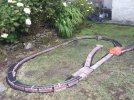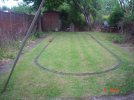I came to this thread hoping to see a discussion of a small layout plan. All I've read about is some kind of proprietary product. Frankly, gentlemen, that is disappointing, and even false advertising. I would far rather see a track plan to learn what the O.P. is up to. Anyway, I have something a little more constructive than all the forgoing to contribute here.
I will never build a model railway at or near ground level. My own is about 39 inches (I'm tall) above ground on benchwork. The benchwork is supported on columns made of concrete blocks, because we have ground dwelling wood-eating insects here, otherwise cedar posts would be adequate. At present my benchwork top surfaces are for the most part made of preserved wood, which being high and usually dry, resists the insects somewhat. However wood warps and twists, so I when things need replacing, I have shifting over to plastic timbers, which are a bit more costly but trouble free. I'm buying them in fairly small quantities at a time, so the cost hasn't been indigestible. I now have an elevated, bug-free, warp-and rot-free railway. I wish I had done this in the first place, decades ago.
The reasons for elevating my railway in the first place go far beyond bugs, rot, warping and twisting. It's all about the view of the trains, accessibility to them, and the drastic reduction of maintenance. I don't have to weed the track. I don't have to deal with washouts, freeze ups, or shifting right of way. I hardly clean the track, or maintain it at all because I use onboard battery power. I can see the sides of the trains; I'm not merely looking down on their roofs all the time. That was very important to me as I don't have the property to step far back from the trains to see the sides at ground level. I can reach my trains without bending, and that is the biggest benefit of all, no matter what one's age.
I have contrived various means of having plant material and other scenic features at my chosen 39" height, but that is another subject. Suffice it to say it can be done, and done brilliantly. Again almost weed-free.
Since I operate my trains like a real railway, delivering the goods and passengers, I'm not merely watching the trains go 'round and 'round, which after a few minutes becomes a crashing bore, and along with all the other follies I've eliminated, explains why so few garden railways get sufficient exercise. That's mighty expensive equipment to just leave sitting on its shelves because getting the railway in shape for operations is just too much work. I say stop messing around on the ground. Eliminate all the drudgery and build a railway that delivers the fun you deserve and want!.
If you, Mr O.P. are planning to run trains at ground level, and especially if you are planning merely to have them run in circles, I implore you to rethink those decisions.
You'll thank me some day.
And for heaven' s sake, next time you begin a thread, don't mislead your readers! Make your title match your content!


